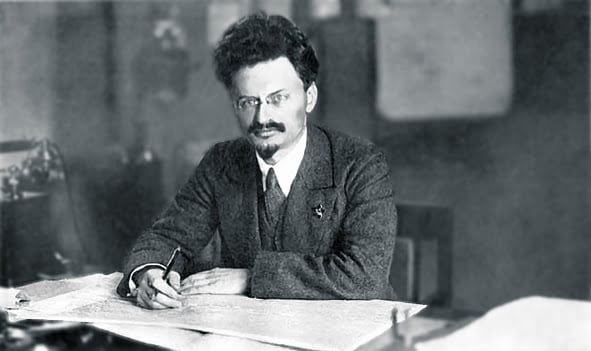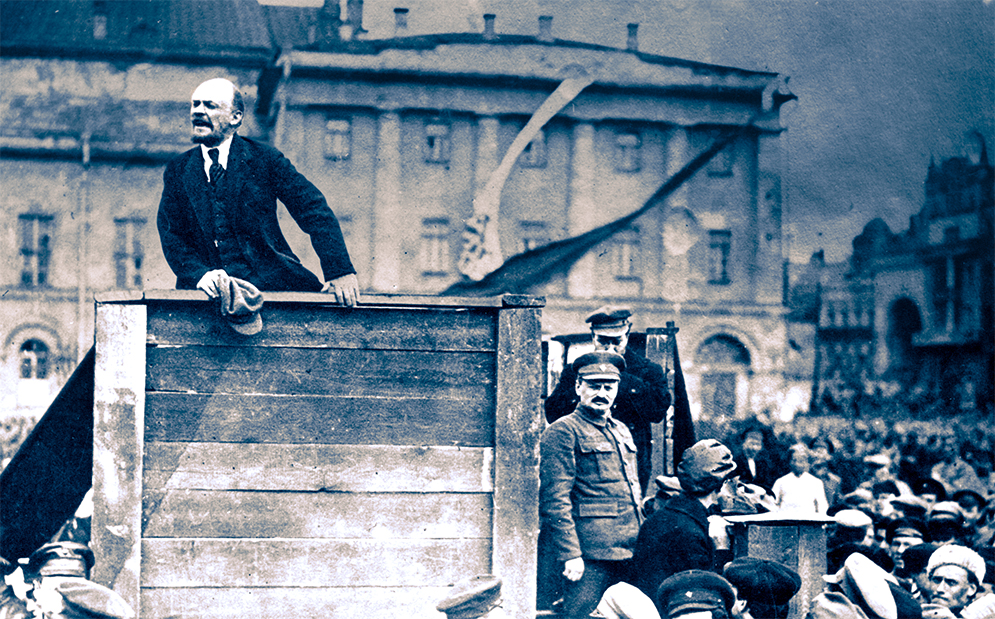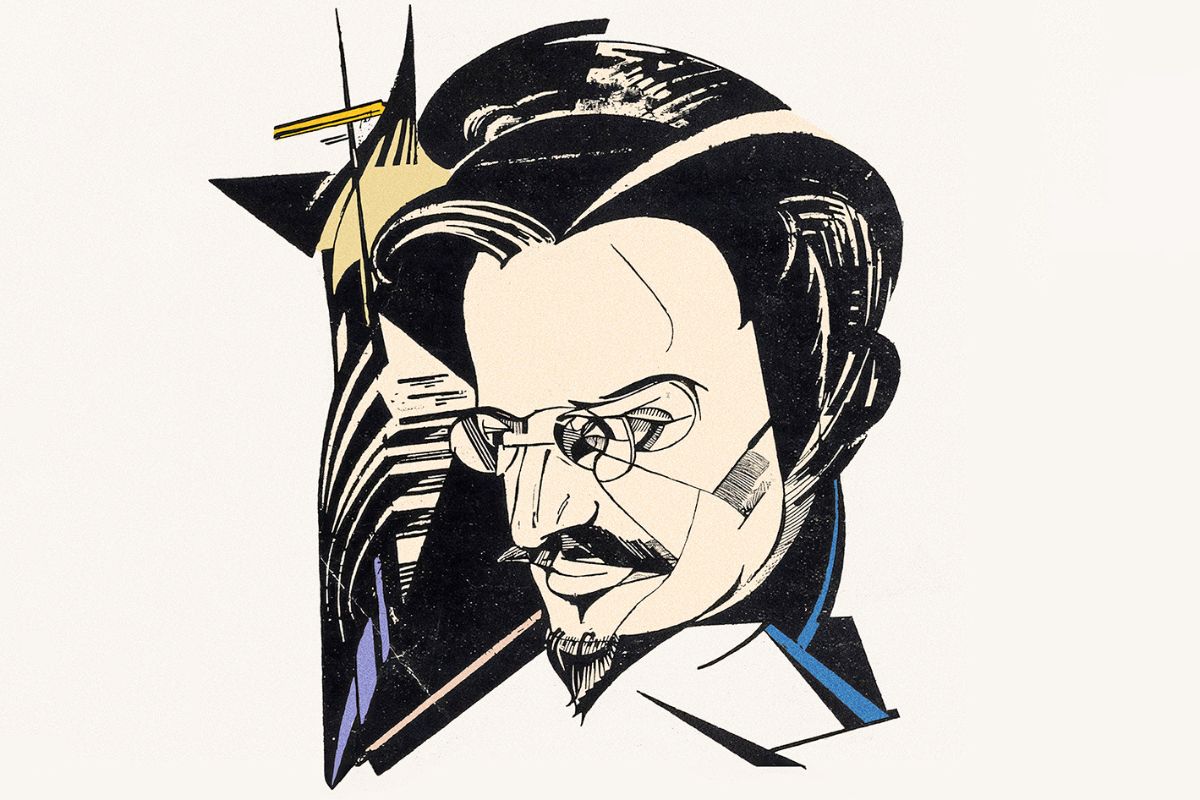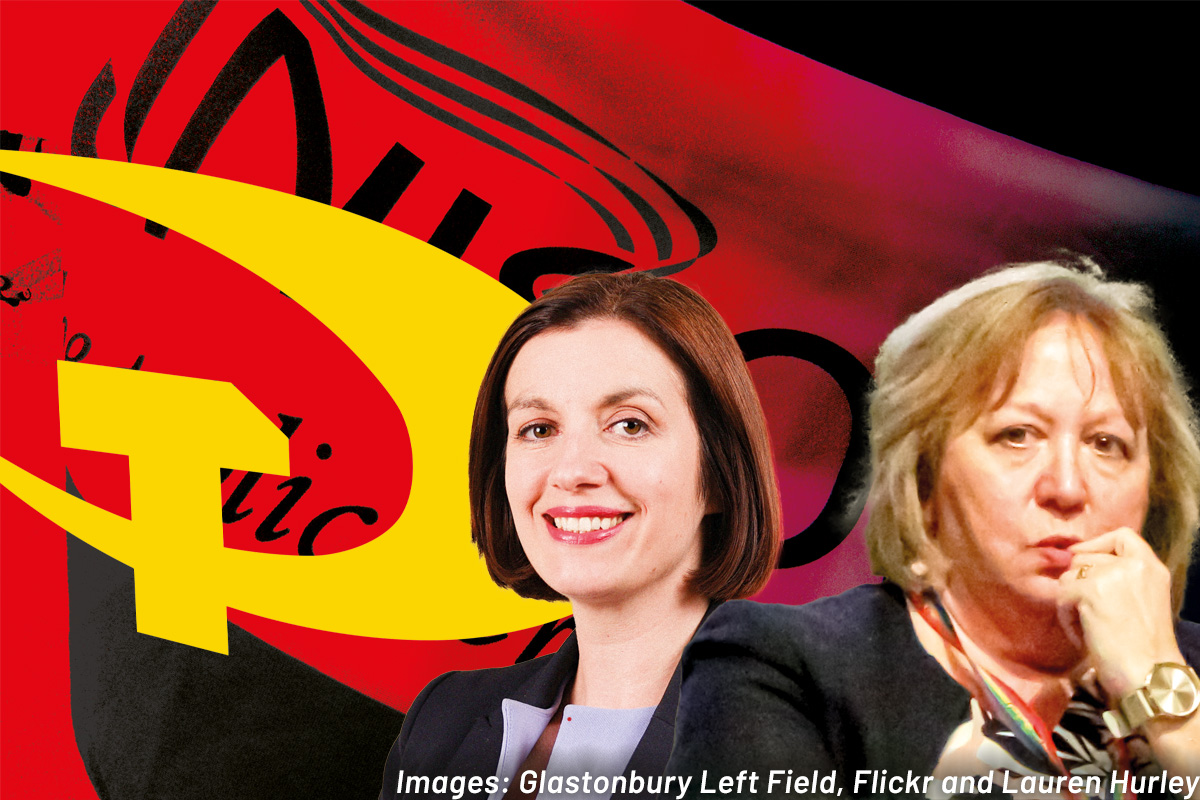The history of the Russian Revolution is intimately associated with the names of Lenin and Trotsky, its two great
leaders. They attracted all the praise and they bore all the hatred. The reason
for this is not difficult to understand. The October Russian Revolution, led by
the Bolshevik Party, was the greatest event in history. For the first time, the
workers and peasant took power into their hands, swept aside the landlords and capitalists,
and proceeded to organise a democratic workers’ Soviet Republic.
The authority of the new Soviet government rested upon a congress of soviets
(workers’ committees) elected from factories and barracks.
Leon Trotsky, who was a political giant, built
and led the Red Army from scratch. After Lenin’s death, it was Trotsky who led
the struggle against Stalinism, for which he paid the ultimate price by his
murder in 1940 at the hands of a Stalinist agent.
Over the recent period there has been an
avalanche of books published to discredit Lenin, Trotsky and the Russian
Revolution. First and foremost of these writers is Professor Robert Service,
the author of several books, including one on Lenin and another on Stalin.
His latest book is a biography of Trotsky,
which is an attempt to link all three figures and bind them to the crimes of
Stalin. This amalgam is not a new method. Its aim is to prove that Bolshevism
leads to Stalinism and totalitarianism and must be condemned in equal measure.
Anti-Communism
Professor Service comes from that breed of
historians and intellectuals whose stock in trade is anti-communism. The task
of these well-paid academics is to discredit Marxism, communism and revolution
in general. Despite all the talk of “objectivity”, Service’s latest book
contains nothing that is original, and is a rehash of all the old slanders and
gossip against Leon Trotsky, one of the greatest revolutionary figures in
history.
Robert Service dismisses Trotsky’s own
autobiography, ‘My Life’, as well as the sympathetic and highly acclaimed
biographies written by Isaac Deutscher and Pierre Broué, which contain,
according to him, “highly disputable judgements”. Service wishes to “correct”
these judgements with his own twisted conclusions.
Service is incapable of understanding
history through the interaction of leaders, parties, classes and groups. He
superficially reduces the historic struggle between Trotsky and Stalin as a
personal or even psychological struggle, devoid of any class content or
interests. “Stalin outplayed him. Trotsky did not go down to defeat at the
hands of ‘the bureaucracy’: he lost to a man and a clique with a superior
understanding of Soviet public life.” (p.4). This is to reduce historical
events to trivia. Trotsky’s defeat is explained simply by personal failings and
not by objective forces.
Liberal dilettantes, such as our learned
professor, have never been able to understand revolutions or
counter-revolutions. For them, such episodes are “excesses” or “accidents” that
have deviated from the “normal” course of history. However, a revolution does
not simply fall from the skies. Liberal bourgeois thought is incapable of
understanding the movement of the masses and those who put themselves on the
standpoint of the working class, as in the case of Lenin and Trotsky. Service
could never understand Trotsky or what motivated him, his strengths and
weaknesses. His motivation is simply to discredit Trotsky and the ideas he
represents.
We are forced to leave aside every calumny
thrown against Lenin and Trotsky, as these would require a book to answer. We
have chosen to concentrate on the key questions raised by Service. According to
the Professor, “Without Lenin, furthermore, Stalinism in the Soviet
Union would have been impossible…” (Lenin: A Political Life,
vol.3, p.xix). This is the crux of the matter. Were Lenin’s and Trotsky’s
methods in essence no different from those of Stalin? Does Bolshevism lead to
Stalinism? What was the struggle between Trotsky and Stalin all about?
The answers to these questions cannot be
found in individual traits or personal combinations, although they play a
certain role, but in the complex relationships between classes and different
social layers and the objective conditions that predominate at the time.
Lenin’s and Trotsky’s lives were bound up
with the revolutionary struggles of their age: the fight against tsarism, the
development of Russian Marxism, the 1905 Revolution, exile, the war years, the
revolutions of 1917, the conquest of power, and the founding of the Communist
International. Trotsky lived on in the fight against Stalinism and the
preparation for a new revolutionary international.
Revolutionary Struggle
In his outstanding autobiography, ‘My
Life’, Trotsky explained “Thus I know well enough, from my own experience, the
historical ebb and flow. They are governed by their own laws. Mere impatience
will not expedite their change. I have grown accustomed to viewing the
historical perspective not from the standpoint of my personal fate. To
understand the causal sequence of events and to find somewhere in the sequence
one’s own place – that is the first duty of a revolutionary. And at the same
time it is the greatest personal satisfaction possible for a man who does not
limit his tasks to the present day.”
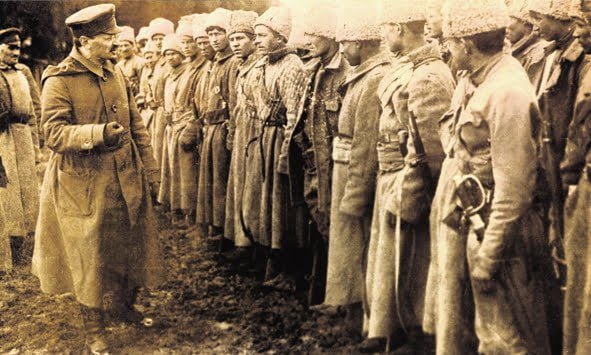 Trotsky’s fall from power after Lenin’s
Trotsky’s fall from power after Lenin’s
death did not represent personal ineptitude but the changed relation of class
forces in Russia
and internationally. The victory of Stalin reflected the isolation of the
revolution in a backward country, surrounded by hostile forces.
In Robert Service’s account of October,
which he typically regards as a “coup”, there is one essential ingredient
missing – the role of the masses on which the revolution is based. In the
aftermath of the revolution, Service concludes “Most people in Russia and the
rest of the world regarded the Bolshevik leadership as a gang of wild
incompetents who could never sustain themselves in power.” (Service, Trotsky, A
Biography, p.189). This is the view of the ruling classes, which Service takes
as representing “most people”, but certainly not of the international working
class which rallied to the cause of the Russian Revolution.
“Bolshevism,” explained Victor Serge, “is
the unity of word and deed. Lenin’s entire merit consists in his will to carry
out his programme… Land to the peasants, factories to the working class,
power to those who toil. These words have often been spoken, but no one has
ever thought seriously of passing from theory to practice.” (From Lenin to
Stalin)
This was the essence of the revolution. In
the civil war and imperialist intervention, the main aim of the imperialists
was the violent overthrow of the revolutionary government and the murder of its
leaders. In August 1918, a Social Revolutionary (member of the peasant party)
shot and nearly fatally wounded Lenin. Trotsky was also the target of repeated
assassination attempts by the White generals.
The first Soviet Constitution guaranteed
every freedom for the workers. There was no thought whatsoever of a
totalitarian state. All political parties, including the capitalist parties,
were free to operate, accept for the fascist Black Hundreds. There was complete
freedom of discussion and debate within the Communist Party. On the issue of
the Brest-Litovsk proposals to sign a predatory peace treaty with Germany in
1918, for instance, Lenin was in a minority. He put forward the proposal that
every group of citizens supported by 10,000 – 15,000 workers should have to
right to issue their own paper if they wanted, the only way to democratise the
press.
The October Revolution was largely a
peaceful affair. “Hardly anyone was arrested”, noted Serge, “and those who
were, were soon released. Among these were Krasnov, Ataman of the Cossacks, who
took advantage of our leniency to start a civil war in the Don country – and
Purishkievich, the anti-Semite leader.” (Ibid) The revolution was still very
naive. As soon as these reactionaries were released they immediately took up
arms against the workers’ state.
The first Soviet government was a coalition
between Bolsheviks and Left Social Revolutionaries, a left wing split off from
the Social Revolutionaries. This only came to an end when the Left SRs joined
the Mensheviks and other counter-revolutionaries, and took up arms against the
government. Only after the summer of 1918 did the revolution hit back in
self-defence. Trotsky organised the Red Army in order to defend the revolution.
“Lenin and Trotsky had become the Siamese
twins of Russian politics”, states Service, “being joined at the hip in their
determination to use ruthless measures including state terror against enemies.”
(Trotsky, a biography, p.190). However, in a situation of civil war and
imperialist intervention to overthrow the Soviet government, what were they to
do, simply fold their arms and pray the counter-revolution would go away?
The counter-revolutionary White forces,
backed by 21 foreign armies, took most of the country and carried out
wide-scale atrocities against the workers and peasants. At one stage, the
Soviet government only controlled Moscow
and the surrounding area. The fate of the revolution was hanging by a thread.
Trotsky succeeded in turning the situation around, but at enormous cost. War
production and famine necessitated rationing in the cities and requisitioning
in the countryside. This is the period of “war communism”, where everything was
directed unavoidably to the war effort and military defence of the Soviet Republic.
Kronstadt Mutiny
This served to stretch things to the
absolute limit. Relations between the peasants and the workers, the cornerstone
of the revolution, reached breaking point. Peasant uprisings broke out in 1920
and early 1921. At this time the Soviet government was faced with a naval
mutiny in Kronstadt. They had no alternative after negotiations broke down but
to crush the rebellion. Failure to do so would have opened the door to military
intervention against Petrograd. These
Kronstadt sailors were not the same revolutionary sailors of October 1917, but
new peasant conscripts under the influence of the counter-revolution. With the
end of the civil war, the New Economic Policy was introduced to placate the
peasants, allowing them to sell their surplus produce, which succeeded in
bringing stability to the countryside.
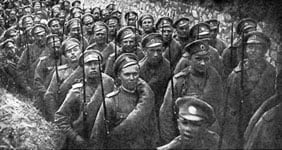 In this life or death situation, the
In this life or death situation, the
Bolsheviks had no alternative but to take emergency defensive measures.
Incidentally, the same was true of Cromwell’s actions in defence of the English
revolution against the Royalist reaction, or Robespierre’s defence of the
French revolution against the feudal regime, or the measures of the Northern
states against the slave-owning owners in the American civil war. “A party
which had seemed doomed to defeat in mid-1918 triumphed by dint of
determination, organisation and leadership”, admits Service. (Trotsky, a
biography, p.245). But then goes on to attack such measures as “ruthless” and
“terror against its enemies”.
The overthrow of the Soviet government
would not have brought with it liberal democracy, but the military fascist
dictatorship of the White generals. That was the alternative to Soviet power
that the imperialists desired.
The Bolsheviks, while defending the
revolution at all costs, never believed the revolution could be sustained for
any length of time in a backward country like Russia. The fate of the Soviet
regime depended upon the world revolution. Lenin believed that if the isolation
was not broken, the Russian revolution would be doomed. He was prepared to
sacrifice everything for a successful revolution in Germany. The only thing they could
do was to hold on as long as possible until help arrived from the west. As we
saw, the revolution did not collapse as Lenin had feared, but suffered a
bureaucratic degeneration in the form of Stalinism.
Stalinism – the opposite of Bolshevism –
grew precisely out of these objective conditions of isolation and terrible
backwardness. After the civil war, the economy was completely shattered. The
country was ruined and subject to famine and disease. The working class had
become atomised. “The terrible crises and the closing down of factories have
compelled people to flee from starvation”, wrote Lenin. “The workers have
simply abandoned their factories; they have had to settle down in the country
and have ceased to be workers.” (Collected Works, vol.32, p.199)
The introduction of the New Economic Policy
in 1921 was a retreat, which gave concessions to the market. It saw the revival
of capitalism in Russia,
together with the merchant, petty employer, rich peasant and black marketer.
This went hand in hand with the growth of bureaucratism in industry, the state
and even the Bolshevik Party. Stalin, who was a secondary figure in the
revolution, became the spokesman for this new social layer that was elbowing
aside the working class.
State Apparatus
“Our state apparatus is so deplorable, not
to say wretched, that we must think very carefully how to combat its defects”,
complained Lenin. (Collected Works, vol.33, p.487). Things became so bad that
Lenin and Trotsky formed a bloc in 1922 to fight the menace of bureaucracy.
This struggle led to Lenin breaking off all personal relations with Stalin.
Lenin stated he was preparing a “bomb” against Stalin. Finally, in his last
‘Testament’ Lenin recommended the Stalin be removed as General Secretary of the
Communist Party and recommended Trotsky “as the most able man on the Central
Committee”.
The wishes of Lenin’s Testament were not
carried out due to the personal intrigues of both Kamenev and Zinoviev, who had
made a rotten pact with Stalin to keep Trotsky out of power. Here we see the
pernicious role of spite in politics and its unforeseen consequences.
Lenin’s death in January 1924 coincided
with the defeat of the German revolution, which provided a double blow to the
morale of the Russian workers. At this time, only one percent of the members of
the Bolshevik Party had held a party card before March 1917. Many of the
advance workers and communists had perished in the civil war. After these
blows, through the agency of Stalin, the bureaucracy took control of the party
and state apparatus. The weight of the Nepmen (petty capitalists created by the
New Economic Policy) and kulaks (rich peasants) grew exponentially. The
pressure of these hostile class forces fed into the party through the rising
bureaucracy.
In late 1924, Stalin came forward with his
anti-Marxist theory of ‘Socialism in one country’, which reflected the
conservative outlook of the bureaucracy. This represented a complete break with
the perspective of world revolution as put forward by Lenin. It also coincided
with a campaign to discredit Trotsky who had established a Left Opposition in
1923 to restore party democracy.
Trotsky defended the position of
revolutionary Marxism against the growing revisionism of Stalin. While
Trotsky’s support rested upon the revolutionary workers, Stalin’s was based
upon the bureaucratic reaction, the millions of petty officials, former tsarist
functionaries, tsarist officers, bourgeois intellectuals, and so forth, who
made their living in the apparatus of state, industry and party. Stalin became
the “chief” of this caste, which now had its own material interests to defend.
In 1926, when Lenin’s widow Krupskaya was close to the Opposition, she stated
“If Lenin were alive today he would now be in prison.”
“Whoever understands history even slightly
knows that every revolution has provoked a subsequent counter-revolution which,
to be sure, has never completely thrown the nation all the way back to its
starting point in the sphere of the economy but has always taken from the people
a considerable part, sometimes the lion’s share, of its political conquests”,
explained Trotsky. “And the first victim of the reactionary wave as a general
rule is that layer of revolutionaries which stood at the head of the masses in
the first period of the revolution, the period of the offensive, the ‘heroic’
period. This general historical observation should lead us to the idea that the
matter is not simply one of the skill, the cunning, or the art of two or a few
individuals, but of incomparably more profound causes.” (Trotsky – Writings
1935-36, p.171)
Stalin’s Revisionism
The years of hardship and defeat had borne
down heavily upon the Russian masses. As the bureaucrats grew in power and
insolence, the voice of the revolutionary workers became weaker. While the
Bolshevik-Leninists around Trotsky drew to their banner tens of thousands of
the best revolutionary fighters, and gathered sympathy from the advanced
workers, this sympathy remained passive. They were exhausted and only a victory
internationally could have stirred them into life. Meanwhile, the Stalinist
bureaucracy railed against “permanent revolution” internationally and
unnecessary upheaval at home. “We will build the socialist society in Russia!” they
proclaimed. This found an echo in the weary and backward masses, which served
to isolate the Bolshevik vanguard. “Therein lies the secret of the victory of
the bureaucracy”, explained Trotsky. “Power is not a prize which the most
‘skilful’ win. Power is a relationship between individuals, in the last
analysis between classes.” (Ibid, pp.176-77).
Dominant Position
Stalin used his dominant position to expel
and exile Trotsky from the Soviet Union. By
the mid-1930s, despite all the capitulations of former oppositionists around
Zinoviev and Kamenev, Stalin decided to eliminate physically all those
connected with the October revolution. The developing revolution in Spain was
threatening to rekindle the enthusiasm of the Russian masses. This would have
sounded the death-knell of the bureaucracy. As a result, Stalin waged a
one-sided civil war against the Old Bolsheviks. This culminated in the purge
trials of 1936-8, where those associated with October were physically
eliminated. Millions perished in the camps and cellars of the secret police.
For those who say, as Service does, that Bolshevism leads to Stalinism, we say
that on the contrary, a river of blood separated Stalinism and Bolshevism.
The only way Stalinism could consolidate
its rule was over the corpses of those communists and Trotskyists who remained
true to the ideals of October. Trotsky fought Stalinism to the death. He
refused to capitulate, as this would only serve to discredit the ideas of
Marxism. Trotsky paid for this with his life.
Clean Banner
Despite all the terrible odds, and the
murder of his close family and collaborators, Trotsky continued to defend the
clean banner of Marx and Lenin against the horrors of Stalinism right up to the
bitter end. The likes of Professor Service are repelled by this. Even Deutscher
failed to understand the real Trotsky, believing he should simply concentrate
on writing and not bother himself with organising the forces of a new
revolutionary international. However, Trotsky regarded this task as the most
important work of his entire life.
Despite the death of Trotsky, his ideas
live on. The collapse of Stalinism, which he predicted, and the global crisis
of capitalism, will once again make these ideas the most attractive ideas in
the world.
“Time was when Trotsky was a frequent topic
of public discussion at least outside the USSR. Those days are gone”, states
Service. However, in today’s crisis, things are changing. There is a renewed
interest in Lenin, Trotsky and their ideas. It is for this reason that Service
has published his books. But they will have little effect.
We should study Trotsky’s writings,
alongside other great teachers of Marxism, which are a treasure house of
experience and theory. With these, the new generation can find the way forward
in the eventual overthrow of capitalism and the establishment of world
socialism. As for the likes of Professor Service, in the words of the Bible,
let the dead bury the dead.

